Capacity: Physical and Neurological


Sport Performance Lab
By Dr. Peter Gorman and Dr. Anne Shadle
The ability to compensate is known as an athlete’s capacity, or resistance to change. Capacity has a foundation in both the physical and neurological aspects of performance and should be analyzed in an environment that equals or exceeds game speed. This article will explain both the physical and neurological sides of capacity and how they can impact performance.
Physical
The center fielder is running in to catch the ball and pulls his hamstring. On the very next play the shortstop ranges left for the ball and as he does, pulls his groin. How many times have you heard a coach say, “I can’t believe what happened to my athlete. He was in the best shape of his life, and while performing a simple task on the field, end ups with a season-ending injury.”
Evaluation and attention to both the physical and neurological attributes of the athlete is highly recommended in any sport.
BFS Balance and Symmetry Overview
Yes, some injuries are instantaneous- for example, if you were running, stepped on a rut and twisted your ankle. However, most injuries are accumulative in nature. What this means is that asymmetries are slowly created in the movement cycle, until the athlete can no longer compensate. Then, just like the proverbial straw that broke the camel’s back, the athlete’s ability to compensate is exceeded and an injury occurs.
Why tell an athlete that their movement screen looks good on a static forward lunge, knowing that an athlete’s capacity to compensate might be fooling the examiner? Does looking good mean that the athlete is going to perform well? Does the good-looking lunge guarantee that as the athlete accelerates at game speed, they will also have equal leg speed, equal acceleration left and right and equal contact and flight time? The 30-yard sprint (in an OptoJump system) performed by USA Baseball is a Game Speed test that exceeds an athlete’s capacity to compensate. In less than five seconds, this test can answer many important questions on lower extremity imbalance. Once the imbalance is shown to exist, THEN employing various movement screens can help pinpoint the cause.
It was not until increased demand and exertion was applied that imbalances appeared, and potential injuries were brought to light. Knowing that athletes harbor varying degrees of capacity to compensate for their imbalances, we have to test the athlete at the highest demand possible so that we are looking at the true athlete and NOT the compensatory process. This high demand testing is designed to exceed an athlete’s capacity, thus eliminating the compensatory ability to mask asymmetries and imbalances. Remember, we never want the game to be the evaluator. Often in this high-tech world, many are still marveling at an athlete’s sprint time, not knowing if the fundamental movements are symmetrical or not. It is all about capacity…we must identify and correct all asymmetries so that they do not accumulate and eventually result in injury caused by simple and/or complex game movements.
Neurological
Ted Williams, known to many as the greatest hitter of all time once said, “Baseball is the only field of endeavor where a man can succeed three times out of ten and be considered a good performer.” Handling stressful conditions, controlling emotions, suppressing distractors, and quick speed of processing are just a few of the neurological functions that the wonderful game of baseball will constantly test in the game. What we find is a person can be prepared physically to perfection, but performance will suffer if their brain is not functioning at its optimal capacity.
We now know in neuroscience that the amygdala is the emotional center of the brain. Every region of the brain can function normally or in standards of deviation above and below normal that affect its function. Without diving too deep, we have also learned that the amygdala has two other sub-regions that control emotions. As heart rate increases the amygdala can change its firing pattern. This will allow emotions to change and, in some cases, rage, thus creating a more indecisive and inefficient player. All players must know that training their brain is as important, if not more so, than training their body.
Anytime we determine brain speed is slowing, we must ask the question why, and make sure that we identify the problem. The answer may be as simple as improving hydration or getting a better night’s sleep.
Each region of the brain can deviate from normalcy, lessening overall brain balance, function and capacity. At the same time, brain speed can slow, which in effect also lessen the athlete’s capacity to perform optimally. As the brain goes out of balance, this can reflect itself in personality changes, or one’s ability to command life’s situations. The way your body can slow and go out of balance, your brain can also slow and go out of balance. As the brain slows, it affects its processing speed and reaction time will increase, in turn affecting all aspects of performance. It is obvious that if an athlete has tremendous brain speed capacity, they would be able to compensate for a longer period of time before a serious condition is recognized. Anytime we determine brain speed is slowing, we must ask the question why, and make sure that we identify the problem. The answer may be as simple as improving hydration or getting a better night’s sleep. If a more serious condition is developing, it is always better to understand it early on, so that the most precise and effective treatment can be given.
Much like increasing demand and load can unearth imbalances physically, the same can be done neurologically. To make sure that we are identifying, nourishing, and balancing the brain properly, we recommend the BrainHQ.com cognitive platform. Brain HQ has numerous, validated, peer-reviewed published papers which ensures that their cognitive trainings are as effective as possible. Designed by brain scientists, Brain HQ exercises have shown to improve a host of cognitive abilities directly related to sports performance like reaction time, processing speed, visual acuity, attention, and memory. Improvements in cognitive abilities and capacity can not only lead to more effective and efficient on-field performance but also transfer to life’s daily tasks.
At USA Baseball, we take pride in not only assessing the physical attributes of our athletes but also the neurological side as well. Evaluation and attention to both the physical and neurological attributes of the athlete is highly recommended in any sport. By being more aware of your physical and neurological strengths or weaknesses, all athletes will be better prepared to help reduce injury and reach their own unique OPTIMAL performance.
